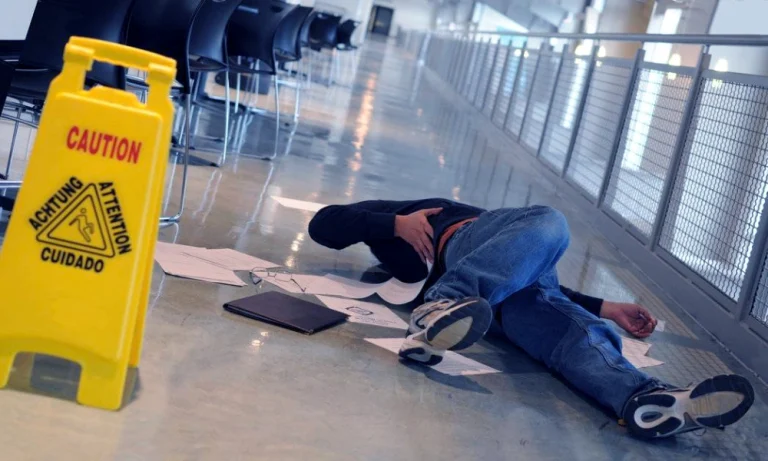Millions of people are treated in emergency rooms each year as a result of fall injuries. This is due to the frequency with which slip-and-fall incidents occur. The term “slip-and-fall” is frequently used to describe a variety of accidents.
A New York Slip and Fall Accident Lawyer will help to gather evidence, determine liability as to who was responsible for your injuries, and will help pursue compensation and justice for you.
Types of Situations that may occur on dangerous walking surfaces
On dangerous walking surfaces, four types of situations can occur.
- Trip-and-fall. This happens when a person stumbles upon an unexpected object while walking.
- Stump-and-fall. This occurs when one of your feet is obstructed by an object.
- Step-and-fall. This occurs when a foot comes into contact with a hole or other unanticipated failure in the walking surface.
- Slip-and-fall. This occurs when contact between the walker’s foot (or feet) and the floor fails to sustain the walker’s center of gravity, resulting in a fall.
What Are the Common Causes of Slip and Fall Accidents
Wet and uneven surfaces
Wet and uneven surfaces are by far the most common causes of slip-and-fall incidents throughout the world. Uneven walking surfaces and wet surfaces, according to statistics, account for more than half of all accidents reported in emergency rooms.
Such accidents occur, especially if the following conditions exist: loose floorboards, cluttered flooring, potholes in parking garages, defective pathways, ripped carpets, poorly built staircases, freshly waxed or washed floors, moisture accumulation, or lose mats.
Weather conditions
Weather is a natural phenomenon over which we have no control. Snow, sleet, rain, and ice accumulation all create hazardous conditions that increase the likelihood of falls on the outsides of businesses and residences.
While property owners cannot control the weather, they are legally required to shovel sidewalks, plow roadways, and salt pathways when inclement weather occurs. If they do not, they may be held liable for any mishaps that occur.
Improper footwear
Regarding footwear, there is a prevalent misconception that women are more prone to sustaining a fall injury, especially when wearing high heels. However, slips and falls aren’t only for ladies in high heels.
Even individuals who wear work boots and sneakers are equally in danger. You will be prone to sliding and falling if your shoes do not provide adequate traction. Slips and falls can occur not only at work but also at home or in public.
Inadequate lighting
When people can’t see, they’re more likely to fall on any surface. Poor lighting makes it difficult to identify hazards. Bright lighting creates a glare on polished floor surfaces, making it more difficult to see.
Pool areas, roads and sidewalks, garages, and stairwells are just a few examples of sites where poor lighting may be quite harmful. Furthermore, a surface that is not dangerous in broad daylight might become dangerous in the dark. It is the property owner’s obligation to ensure that pedestrian areas are adequately lit.
Poor safety training
According to the national floor safety institute, employees in enterprises and construction sites ought to obtain sufficient training to not slip and fall while on the job. This includes special instructions on how to recognize and avoid risks, how to operate equipment properly, how to use and secure ladders, and how to wear slip-resistant shoes.
Every employer is responsible for providing a safe workplace. Unfortunately, some employers take occupational safety instructions lightly or completely ignore them, putting their employees and even customers at risk of a fall accident.
Lack of or defective handrails and banisters
Handrails are an important safety feature on a staircase. They allow people to maintain their balance while ascending or descending stairs. They also give a person something to hold onto if they lose their balance.
The absence of handrails is problematic since it eliminates one of the most important safety measures. A faulty handrail might lead a person to lose their balance or grasp and fall.
Tripping hazards
Trash or debris on the floor, wires running across walkways, open desks or cabinet drawers, and transitions from one type of surface to another, such as carpet to wood, are all examples of hazards. Cords and wires are the most common tripping hazards. Many people are preoccupied while walking.
More often than not, they do not notice the wires and cords strewn over the floor. These cables and wires hook the shoes or force the legs to slide, causing pedestrians to slip and fall. The parties involved should take control and correct the issue.
Nursing home neglect
Unfortunately, falls are common in nursing homes. The majority of patients admitted to hospitals are elderly and frail. This is a major contributor to slip-and-fall accidents because they are frequently ignored. With age and illness, one’s sense of balance deteriorates. As a result, they are more vulnerable to injuries from falls. Such an incident could result in death or severe deterioration of their current condition.
Injuries in Slip-And-Fall Accidents
Some people walk away from a slip-and-fall accident with only minor scrapes and bruises, but not everyone is so fortunate. Some of these falls, particularly in older adults, can result in painful, long-term, life-threatening injuries and irreversible disability.
According to the national institute, falls are a health risk and the leading cause of fatal and nonfatal injuries among the elderly. Falls can also limit an elderly person’s ability to live independently. Slip-and-fall accidents can result in:
Trauma to the head or brain. Slip-and-fall accidents frequently result in TBIs and other severe head injuries. Head trauma, damaged tissues, and bleeding are all possible outcomes for the brain in this situation. Severe brain damage can have serious consequences, including death.
Injuries to the spinal cord. Slipping and falling, then landing on your back, can cause a dislocation, fracture, or even crush and compress one or more vertebrae. This can result in paralysis or long-term spinal cord damage. Treatment for such severe injuries will almost certainly be lifelong and expensive.
Bruised and broken bones. Recent studies show that about 5 percent of all slip-and-fall accidents resulting in emergency room visits involve broken bones. A major bone, such as the pelvis or hip, can be broken in a fall. As a result, not only are they less mobile, but their quality of life suffers as a whole. Additionally, fractures sustained from falls can have lasting effects. They also call for extensive medical care and treatment that can take a lot of money and time.
Additionally, fall accident victims may suffer from sprained or strained muscles, soft tissue injuries, and joint dislocation.
Filing a Personal Injury Lawsuit
If you were injured or suffered financial losses as a result of a slip and fall, you can seek legal redress through a slip and fall case. However, you must show that a negligent property owner or employee caused your accident and injuries. When it comes to proving negligence, things can get complicated.
A consultation with a personal injury lawyer may be beneficial in constructing your case against an at-fault person. In general, you must demonstrate several key things. These include:
- The property owner or employee did not keep the environment safe.
- They violated their responsibility of care (negligence).
- You were harmed as a result of their carelessness.
- As a result, you have suffered losses.
You may find it difficult to prove fault in your slip-and-fall lawsuit. A defendant may allege that you were to blame for the accident and acted in a way that either contributed to or caused it.
Compensation in a Slip and Fall Claim
If a property owner’s or other accountable party’s negligence causes an accident and injuries, they may be held liable for compensating the victim for any financial losses and suffering. People can be compensated in the following ways:
- All medical expenditures, including future bills
- The price of medical equipment such as crutches or a wheelchair.
- Wages lost and any future income lost
- Transportation expenses
- Expenses incurred out of pocket
- A housekeeper or a health aide
- Awards for physical and emotional distress
- Quality of life awards
Other types of compensation are available to fall, accident victims, depending on the severity of their injuries and the likely long-term consequences of those injuries.
Preventing a Slip-And-Fall Accident for Property Owners
Because slips and falls are so common, there are steps that can be taken to reduce the likelihood of people falling. These are some examples:
- Watch where you are going.
- Mopping wet surfaces.
- Repairing sidewalks and parking lots.
- Removing snow and ice before they accumulate.
- Using anti-skid paint and adhesive stripping.
- Using moisture-absorbing mats at the entrances.
- Attending to spills quickly before anything happens.
- Wear proper shoes.
- Reduce wettable or slippery surfaces.
- Remove obstacles from aisles and obstacles.
- Create and maintain proper lighting.
- Removing any strings, cords, or cables that could be crossing walking areas or hallways.
- Clearing the paths that often have heavy foot traffic.
- Encouraging all the workers to close drawers or cabinets at all times when they are not in use.
Slip and fall FAQ
1. What is the meaning of a slip-and-fall accident?
A slip-and-fall case occurs when someone gets wounded while on another person’s property. According to the law, this is a sort of “premises liability,” and the at-fault party is thus responsible for damages to the plaintiff if the landowner has broken a duty owed to the plaintiff.
2. What do I do if I slip and fall?
The first thing you should do after falling is checked to see if you are injured. If you are not injured, feel around your body for any pain or injuries before attempting to get up from the floor. If you are hurt or unable to get up, call for assistance.
3. What are the three most common causes of slips?
Slips, trips, and falls can happen for a variety of reasons. Cleaning methods, flooring types, footwear, lighting levels, the contrast between floors, walls, and doors, and obstructions or other trip hazards are all examples.
4. Is a slip-and-fall accident a personal injury?
Slip and fall accidents are a form of personal injury. It applies to circumstances in which someone else’s property was not maintained in a safe condition or someone else’s carelessness led you to slip and fall.
5. Do I need a lawyer?
Some people prefer to represent themselves. However, this is not advised. Because these are complicated situations, you should contact a lawyer to represent you.
6. How can a lawyer be of help?
If you were injured in a slip and fall accident, a professional attorney can help you recover compensation for your medical bills, lost wages, and pain and suffering. They could also give you legal advice, gather evidence to back up your claim, negotiate with the defendant’s insurance on your behalf, and represent you in court if the fall case goes to trial.
7. Where can I get a lawyer?
Slip and fall accidents are covered under premises liability law. Many insurance companies begin preparing a case soon after you report an injury in order to reduce your settlement. In the event that you suffer a back injury, spinal cord damage, or another major injury as a result of a slip and fall, you should call our attorneys promptly before getting the insurance company involved.
Our attorneys at Gregory Spektor & Associates P.C. prepare every case as if it were going to trial, and we are willing to go to any length to secure the compensation you require and deserve. Allow us to handle all case details to assist you in healing.
Call us today for a free case review. You can also visit our offices or connect with us online to get started on any slip and fall accident.



